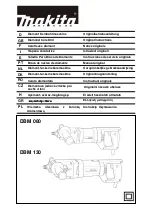
8 ENGLISH
Speed change
CAUTION:
Always set the speed change lever
fully to the correct position.
If you operate the
tool with the speed change lever positioned halfway
between the "1" side and "2" side, the tool may be
damaged.
CAUTION:
Do not use the speed change lever
while the tool is running.
The tool may be damaged.
Displayed
Number
Speed
Torque
Applicable
operation
1
Low
High
Heavy load
-
ing operation
2
High
Low
Light loading
operation
To change the speed, switch off the tool first. Push
the speed change lever to display "2" for high speed
or "1" for low speed but high torque. Be sure that the
speed change lever is set to the correct position before
operation.
If the tool speed is coming down extremely during the
operation with display "2", push the lever to display "1"
and restart the operation.
►
Fig.6:
1.
Speed change lever
Adjusting the fastening torque
►
Fig.7:
1.
Adjusting ring
2.
Graduation
3.
Arrow
The fastening torque can be adjusted in 22 levels by
turning the adjusting ring. Align the graduations with the
arrow on the tool body. You can get the minimum fas
-
tening torque at 1 and maximum torque at
marking.
The clutch will slip at various torque levels when set at the
number 1 to 21. The clutch does not work at the
marking.
Before actual operation, drive a trial screw into your
material or a piece of duplicate material to determine
which torque level is required for a particular applica-
tion.
The following shows the rough guide of the relationship
between the screw size and graduation.
Graduation
1
2
3
4
5
6
7
8
9
10 11 12 13 14 15 16 17 18 19 20 21
Machine screw
M4
M5
M6
Wood
screw
Soft wood
(e.g. pine)
–
ø
3.5 x 22
ø4.1x 38
–
Hard wood
(e.g. lauan)
–
ø
3.5 x 22
ø4.1x 38
–
ASSEMBLY
CAUTION:
Always be sure that the tool is
switched off and the battery cartridge is removed
before carrying out any work on the tool.
Installing or removing driver bit/
drill bit
►
Fig.8:
1.
Sleeve
2.
Close
3.
Open
Turn the sleeve counterclockwise to open the chuck
jaws. Place the driver bit/drill bit in the chuck as far
as it will go. Turn the sleeve clockwise to tighten the
chuck. To remove the driver bit/drill bit, turn the sleeve
counterclockwise.
Installing hook
WARNING:
Use the hanging/mounting parts
for their intended purposes only, e.g., hanging the
tool on a tool belt between jobs or work intervals.
WARNING:
Be careful not to overload the
hook as too much force or irregular overburden
may cause damages to the tool resulting in per-
sonal injury.
CAUTION:
When installing the hook, always
secure it with the screw firmly.
If not, the hook
may come off from the tool and result in the personal
injury.
CAUTION:
Make sure to hang the tool
securely before releasing your hold.
Insufficient
or unbalanced hooking may cause falling off and you
may be injured.
►
Fig.9:
1.
Groove
2.
Hook
3.
Screw
The hook is convenient for temporarily hanging the tool.
This can be installed on either side of the tool. To install
the hook, insert it into a groove in the tool housing on
either side and then secure it with a screw. To remove,
loosen the screw and then take it out.
Using hole
WARNING:
Never use the hanging hole for
unintended purpose, for instance, tethering the
tool at high location.
Bearing stress in a heavily
loaded hole may cause damages to the hole, result
-
ing in injuries to you or people around or below you.
►
Fig.10:
1.
Hanging hole
Use the hanging hole at the bottom rear of the tool to
hang the tool on a wall using a hanging cord or similar
strings.









































